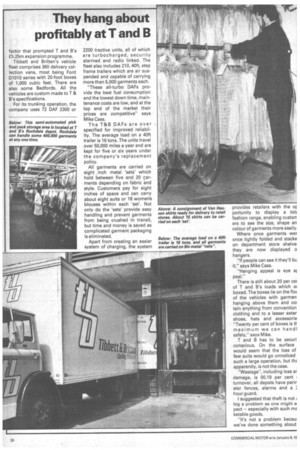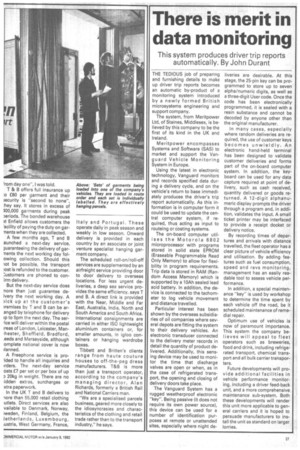They hang about profitably at T and B
Page 19

Page 20

Page 21

If you've noticed an error in this article please click here to report it so we can fix it.
Mike Rutherford looks at Tibbett and Britten's claim to be Britain's leading hanging garment distributor. The entries in their traffic books cover the UK, Europe, the Near, Middle and Far East, Australasia and the American COntinent
BBETT AND BRITTEN arrived 1 the transport scene in 1959 hen an enterprising transport )erator, John Tibbett, disco:red that he could deliver garents from manufacturer to reilers on hangers. That may not revolutionary; it is not what )hn Tibbett did, but how he did
— horizontally suspending -oom handled in the back of a :livery van to hang the garents on. That must be the leapest innnovation ever.
Since then T and B's operation is grown from three delivery ins based at a mall ware)use in London's East End, to a itionwide service with a netork of 11 depots, a fleet of over O artics and delivery vans, indling well over 100 million irments a year. It employs a 3ff of about 1,250, a third of hich are drivers.
Throughout the late 1960s and rly Seventies the company exinded rapidly. It now claims to the largest specialist clothing insport company in Europe.
In 1969 SPD, the Unilevervned transport group, and van 3nd and Loos, the road transort subsidiary of Dutch Rail30, each acquired a 49 per cent shareholding in T & B. A year later the company had depots at Tottenham, Durham, Leicester and East Kilbride handling about 850 garments a year, and the following year, more depots were opened at Edmonton, Bristol and Belfast.
By 1973 the first custom built depots were opened in East Kilbride, Rochdale and Hackney, and over the following two years new depots were acquired in Hayes and Leicester.
T and B had nine depots in the UK with 289,000 sq ft of handling and storage space by 1977, The following year it announced a £5.25m expansion programme which included the opening of a new 75,000 sq ft depot an Enfield, a 30,000 sq ft depot at Morley, and also the mechanisation of the Rochdale depot. Capacity at Rochdale was doubled with the installation of a custom-built mechanical handling system which included two miles of overhead speedrail. Between 1977 and 1979 T and B doubled its traffic. It now handles 140 million garments a year through its depot network.
Describing how the company evolved its philosophy of "growth through specialisation", general manager national division, Mike Cass notes the significance of the 1968 Transport Act. "This was really the start of 'specialisation', of carriers providing a dedicated service to a specific market."
At this point T and B decided to provide a complete nationwide service.
"We had to achieve the right balance between the number of depots required and frequency of access to delivery outlets. At the same time, we had to find ways of utilising equipment and staff during the traditional tough periods in the fashion industry which is, after all, cyclical," said Mike Cass.
There was a "logical realisation" on the part of both manufacturers and retailers to concentrate their efforts in their own areas of specialisation — manufacturing and selling — and to let other specialists provide the link between them, says T and B. And that is where it stepped in.
The company responded and provided comprehensive warehousing facilities, including sorting, labelling, pressing, packing and order consolidation. It also provided daily collection/delivery of hanging and boxed garments and other fashion accessories. That has led to T and B cornering 60 per cent of the market share in hanging garment transport.
"The early Seventies MS a period of steady controlled growth and we saw our traffic grow from a throughout of 4m garments in 1970 , to 59m in 1976," says Mike Cass. He is confident that the current throughput of around 140m garments annually will steadily rise as more manufacturers and retailers turn to specialists for their distribution needs.
Part of that "controlled growth" came in 1978 when T and B won all the hanging garment national distribution for Marks and Spencer's 253 retail outlets in the UK. This was one factor that prompted T and B's £5.25m expansion programme.
Tibbett and Britten's vehicle fleet comprises 360 delivery collection vans, most being Ford D1010 series with 20-foot boxes of 1,000 cubic feet. There are also some Bedfords. All the vehicles are custom made to T & B's specifications.
For its trunking operation, the company uses 72 DAF 2300 or 2200 tractive units, all of which are turbocharged, security alarmed and radio linked. The fleet also includes 210, 40ft, step frame trailers which are air suspended and capable of carrying more than 5,000 garments each.
"These all-turbo DAFs provide the best fuel consumption and the lowest down time, maintenance costs are low, and at the top end of the market their prices are competitive" says Mike Cass.
The T&B DAFs are over specified for improved reliability. The average load on a 40ft trailer is 16 tons. The units travel over 50,000 miles a year and are kept for five or six years under the company's replacement policy.
All garments are carried on eight inch metal 'sets' which hold between five and 20 garments depending on fabric and style. Customers pay for eight inches of space and can carry about eight suits or 18 women's blouses within each 'set'. Not only do the 'sets' provide easy handling and prevent garments from being crushed in transit, but time and money is saved as complicated garment packaging is eliminated.
Apart from creating an easier system of charging, the system provides retailers with the or portunity to display a tot fashion range, enabling custorr ers to see the size, shape an colour of garments more easily Where once garments wer once tightly folded and stacke on department store shelve they are now displayed o hangers.
"If people can see it they'll bu it," says Mike Cass.
"Hanging appeal is eye al peal."
There is still about 20 per cei of T and B's loads which al boxed. The boxes lie on the floc of the vehicles with garmen hanging above them and col tam n anything from convention clothing and to a lesser exter shoes, hats and accessorie "Twenty per cent of boxes is tt maximum we can handl safely," says Mike.
T and B has to be securi conscious. On the surface would seem that the loss of few suits would go unnoticed such a large operation, but thz apparently, is not the case.
"Wastage", including loss ar damage, is 00.19 per cent turnover, all depots have perir eter fences, alarms and a : hour guard.
I suggested that theft is not big a problem as one might e pect — especially with such rm. ketable goods.
"It's not a problem becau we've done something about :rom day one", I was told.
T & B offers full insurance up :o £80 per garment and their 3ecurity is "second to none", bey say. It stores in excess of 100,000 garments during peak 3eriods. The bonded warehouse )t Enfield allows customers the 'acility of paying the duty on garnents when they are collected. A few months ago, T and B aunched a next-day service, juaranteeing the delivery of garnents the next working day folowing collection. Should this lot be possible, the transport :ost is refunded to the customer. :ustomers are phoned to conirm delivery.
But the next-day service does nore than just guarantee devery the next working day. A )ick up at the customer's nemises by T and B can be aranged by telephone for delivery ip to 5pm the next day. The serIce will deliver within the postal Imes of London, Leicester, Manhester, Sheffield, Bradford,. .eeds and Merseyside, although omplete national cover is now planned.
A Freephone service is pro'Wed to handle all inquiries and irders. The next-day service osts £7 per set or per box of up 3 20kg in weight. There are no lidden extras, surcharges or xtra paperwork.
In the UK T and B delivers to lore than 55,000 retail clothing lutlets. Direct services are also vailable to Denmark, Norway, ;weden, Finland, Belgium, the letherlands, Luxembourg, ustria, West Germany, France, Italy and Portugal. These operate daily in peak season and weekly in low season. Onward delivery is provided in each country by an associate or joint venture specialist hanging garment company.
The scheduled roll-on/roll-off services are supplemented by an airfreight service providing door to door delivery to overseas locations. For less urgent deliveries, a deep sea service provides the same efficiency, says T and B. A direct link is provided with the Near, Middle and Far East, Australia, India, North and South America and South Africa. International consignments are carried in either ISO lightweight aluminium containers or, for smaller amounts, in igloo containers or hanging wardrobe boxes.
Tibbett and Britten's clients range from haute couture houses to off-the-peg dress manufacturers. T&B is more than just a transport operator, according to the company's managing director, Alan Richards, formerly a British Rail and National Carriers man.
"We are a specialised parcels business, geared more closely to the idiosyncrasies and characteristics of the clothing and retail trade rather than to the transport industry," he says.










































